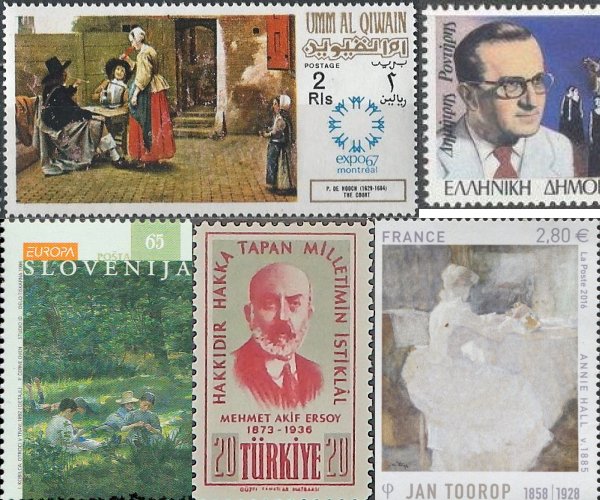The Arts on Stamps of the World — December 20
An Arts Fuse regular feature: the arts on stamps of the world.

By Doug Briscoe
The pickings are slim today, but how else could one possibly follow the birthday of William Marx? We’ll do the best we can with three painters and risk a brawl by juxtaposing a Turkish poet and a Greek stage director.
The first of our painters was Pieter de Hooch (baptized 20 December 1629, buried 24 March 1684) of the Dutch Golden Age. A contemporary and countryman of Vermeer, de Hooch also specialized in interior genre paintings, often with open doorways offering secondary views, as in Courtyard of a House in Delft (1658, not on a stamp). He was born in Rotterdam and worked there as well as in Delft (Vermeer’s birthplace) and Amsterdam. His teachers are thought to have included Nicolaes Berchem and Carel Fabritius. The five stamps for de Hooch come from five different countries and show five different paintings: from Oman comes Woman with a Child in a Pantry (c1660, note open door); from Hungary, Woman Reading a Letter (1664), not to be confused with A Woman Reading a Letter and a Man at a Window (c1668-70) from Burundi (which has an open door); from Umm al Qiwain the congenial A Dutch Courtyard (1658/60, ditto open door), and from the Netherlands a stamp with a painting I couldn’t identify by name despite having found an image of it on the Web. FYI, the Museum of Fine Arts Boston has Interior of a Dutch House (with open door, c1680). An expansive and informative Web page on de Hooch has been put up by a gentleman calling himself Senex Magister.

Painter No. 2 today is Jan Toorop (20 December 1858 – 3 March 1928), whose work adopted a variety of styles over time. The Dutch-Indonesian painter was born and grew up to the age of ten on the island of Java, then, as it happens, furthered his schooling in the municipalities of his artistic forebears de Hooch and Vermeer: Delft and Amsterdam. For a few years he lived in Brussels as a member of the group Les XX. Toorop dabbled in Impressionism, Symbolism, Realism, Post-Impressionism, Art Nouveau, and Pointillism, occasionally employing Javanese motifs. In 1905 he converted to Catholicism and painted religious canvases, and he also produced work in the form of posters, book illustrations, and stained glass. Toorop had to wait for the 21st century before receiving a stamp, but his homeland has done him proud with issues from 2001, O grave, where is thy Victory (1892) and 2002, Landscape with Canal. France honored him just last year with Symphony in White (1885), Toorop’s portrait of his English wife, whose name happened to be Annie Hall (“Honey, there’s a spider in your bathroom the size of a Buick”).
Our third December 20 painter is Ivana Kobilca (20 December 1861 – 4 December 1926), the most highly regarded of female Slovene painters. Born in Ljubljana, she studied in Vienna and had her work exhibited in 1888. Her work was of the Realist style and, although leaning in the Impressionist direction, never quite made the leap. The nation of Yugoslavia remembered her with a stamp of her charming picture Summer (1889-90). Subsequently Slovenia gave us Children on Grass and Bouquet of Dahlias, one of Kobilca’s numerous still lifes. Here, too, is a link to her Self-Portrait in White, dated about 1910.

Born in Istanbul to parents of Albanian, Uzbek, and Turkish blood, the poet Mehmet Âkif Ersoy (20 December 1873 – 27 December 1936) is revered by the Turks as an instrumental figure in the post-World War I Turkish War of Independence and as the author of the Turkish National Anthem. All the same, he seems to have only a single set of three stamps issued in 1956. His image did also appear on the reverse of the 100 lira Turkish banknote in the 1980s. A devout man, Ersoy made patriotic sermons in mosques, arguing for the expulsion of Western powers following the disintregration of the Ottoman Empire. Apart from the anthem, adopted in 1921, he is known for his 1911 poetry collection Safahat.
The precise birth date of Greek actor and stage director Dimitris Rontiris appears to be unknown. He died on December 20, 1981. Born in Piraeus in 1899, he studied law and turned to acting in 1919. His travels took him to Vienna and Berlin, where he met Max Reinhardt, and on his return to Greece he took up directing. He served as director of the Royal and Greek National Theaters from the 1930s to the 50s, not abandoning his work as an actor.
A graduate of the University of Massachusetts with a B.A. in English, Doug Briscoe worked in Boston classical music radio, at WCRB, WGBH, and WBUR, for about 25 years, beginning in 1977. He has the curious distinction of having succeeded Robert J. Lurtsema twice, first as host of WGBH’s weekday morning classical music program in 1993, then as host of the weekend program when Robert J.’s health failed in 2000. Doug also wrote liner notes for several of the late Gunther Schuller’s GM Recordings releases as well as program notes for the Boston Classical Orchestra. For the past few years he’s been posting a Facebook “blog” of classical music on stamps of the world, which has now been expanded to encompass all the arts for The Arts Fuse.
